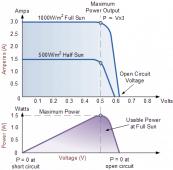You didn't say poly even once.
When not connected a HQST HSP100P-L 100W poly panel should read 21.6V in full sun and moderate temperatures. Four panels in series should read 86.4V. I don't know why you insist 72V is a normal open circuit reading for your setup.
That's how an MPPT works. You are obsessed over this drop from 72V to 55V, but a ~20% drop is perfectly normal. Look at this chart for a single smallish solar cell. When not connected it reads a little over 0.62V in full sun. But that's with zero current and thus zero power. A MPPT will reduce the voltage and increase the current to operate at the maximum power point at 0.5V (a ~20% drop). That's the voltage drop you see when you flip the breaker. It's not a malfunction or "poor marketing".
View attachment 110678
The MPPT will always try to operate at the max power point UNLESS your panels can put out more power than the MPPT can feed into the battery. Then the MPPT will drop the voltage even further. That should not happen when you connect four panels. So a 60A MPPT should not act any differently when you connect four panels.
Will a 60A MPPT pull more power from eight panels? It depends. As long as your array measures 72V when disconnected I'd say no, the 60A unit will not help. If conditions change and your Voc gets closer to the 84.6V spec value then a 60A MPPT might help. But it will still show a ~20% voltage drop when you flip the breaker, because that's what it's supposed to do.
Frankly, I believe the test data published in their manual over some random customer support dude.



